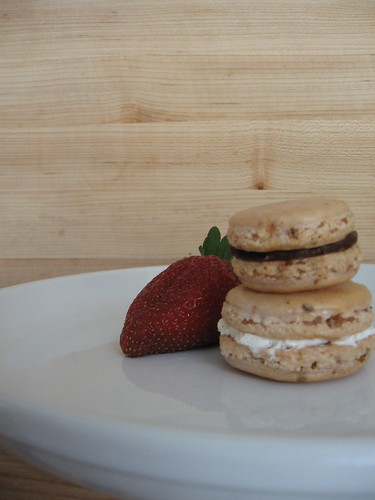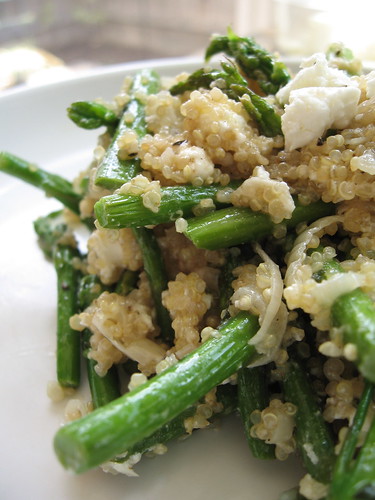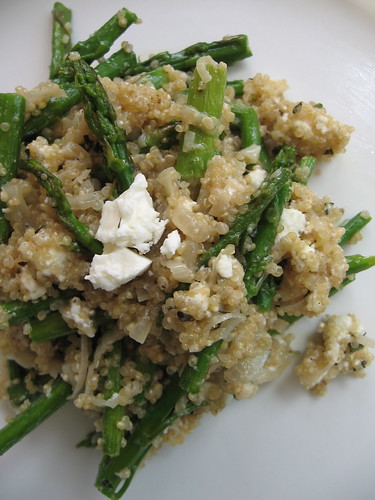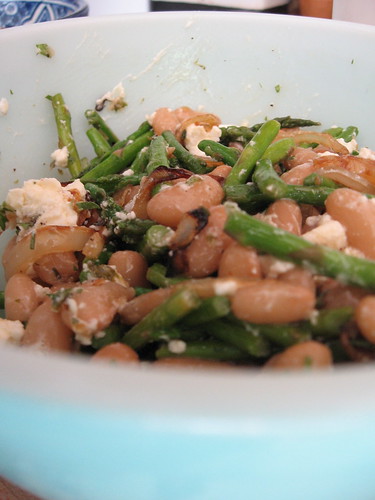The truly challenging part of this month's exercise was devising the edible container. Something with bacon sounded appealing, but boring—living in L.A. often means I'm quickly exhausted with new food trends, and the bacon-as-dessert phenomenon has been no exception.
I've been spending a lot of time traipsing through Tartelette's blog recently, and she has a dangerous skill: her food is so beautiful that I want to make it all right now, just this second. Luckily for my waistline, my budget doesn't allow for such profligacy, but as I thought about mousse, I couldn't get these beautiful mousse cakes off my mind.
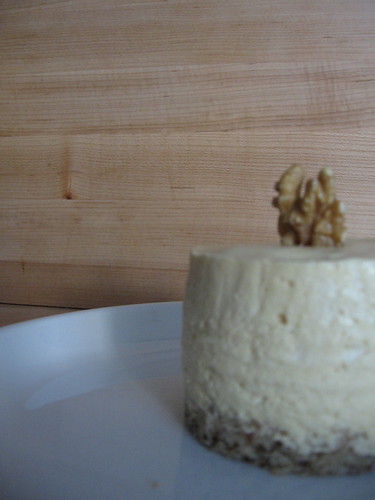
A couple hours and a few dirty dishes later, magic happened. The cake was moist and surprisingly boozy for only having two tablespoons of bourbon, and the flavor offset the maple mousse quite well.
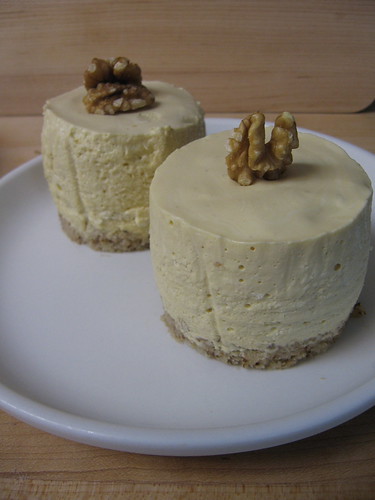
I don't know that it's not much of a container, and the molds were a little bit messy, but for someone who specializes in a simple scoop of ice cream, a rustic crumble, or some fruit tossed in sugar and tossed into a tart crust to bake, these little mousse cakes were almost too elegant to eat. Almost.
Maple Mousse with Walnut-Bourbon Cake
Inspired by several desserts from Tartelette; mousse recipe adapted very slightly from that provided by Evelyne.
If you don't like the taste of bourbon, leave it out—for such a small amount, it packs a lot of flavor.
For the cake:
1 ¼ cups unbleached all-purpose flour
¾ cup ground walnuts (a scant cup of walnut halves or pieces)
¾ cup granulated sugar
¼ cup dark brown sugar
1 tablespoon baking powder
¼ teaspoon salt
½ cup egg whites (from 3-4 eggs)
¾ cup milk (I used whole)
2 tablespoons bourbon
½ cup (1 stick) butter, melted
For the mousse:
1 cup Grade B all natural maple syrup
4 large egg yolks
1 tablespoon gelatine (7 grams; generally one envelope)
1 ½ cups heavy cream, divided
Preheat oven to 300°F. Line a half-sheet pan with parchment paper, lightly butter the paper, and set aside.
Pulse the walnuts in a food processor until finely ground but not pasty; measure ¾ cup ground nuts and reserve the rest for another use. Combine dry ingredients in a large bowl and stir to mix. Whisk the egg whites just to break them up, then combine with milk.
Add the egg-and-milk mixture to the dry ingredients and stir just until combined. Add the bourbon and melted butter and stir gently until smooth.
Scrape the batter into the pan, smoothing into one layer with a spatula. Bake, turning once after about 10 minutes, until the cake is springy and a skewer comes out clean, 20-30 minutes. Remove to a rack to cool.
To prepare the molds:
Line the inside of up to eight 3 inch molds (you can use soup cans, cleaned and both ends removed, if needed) with parchment paper. Cut the cake into rounds, then carefully place in the bottom of the lined molds and set aside.
To make the mousse:
Bring the maple syrup to a boil in a small saucepan and remove from heat. Whisk the yolks in a medium bowl. Temper the yolks by carefully and slowly pouring some of the hot syrup over while whisking vigorously. Whisking the syrup, transfer the warmed yolk mixture back to the saucepan. Set aside.
Measure ¼ cup cream into a small bowl and sprinkle with the gelatin; let rest five minutes. Carefully heat the cream in the microwave (about 45 seconds) or over a bain-marie of simmering water (a minute or two) without stirring until the gelatine is completely dissolved. Whisk into the maple mixture until well combined. Let the maple mixture cool one hour, whisking occassionally, until just over room temperature and the approximate texture of egg whites.
Meanwhile, whip the remaining 1 ¼ cup cream to stiff peaks; refrigerate.
When the maple mixture has cooled as above, stir about ¼ of the whipped cream to lighten the mixture. Scrape the remaining whipped cream into the maple mixture and fold together until just combined.
Pour the mousse gently into the molds; if you prefer the mousse by itself, simply pour it into individual dessert cups (or keep it in the large mixing bowl). Refrigerate until set, at least one hour and preferably longer.
Makes at least 8 generous dessert portions, with leftover cake scraps

